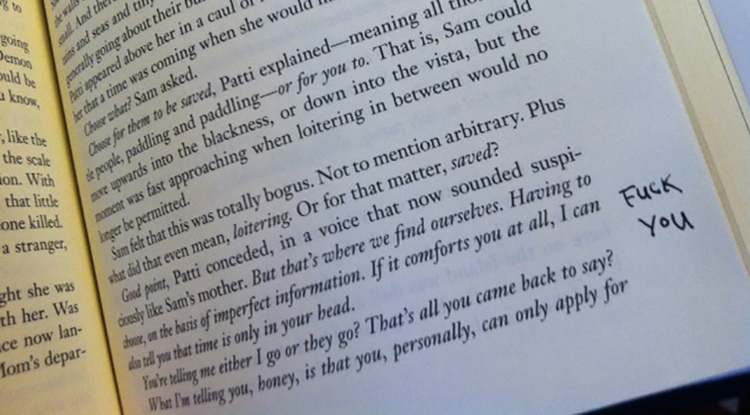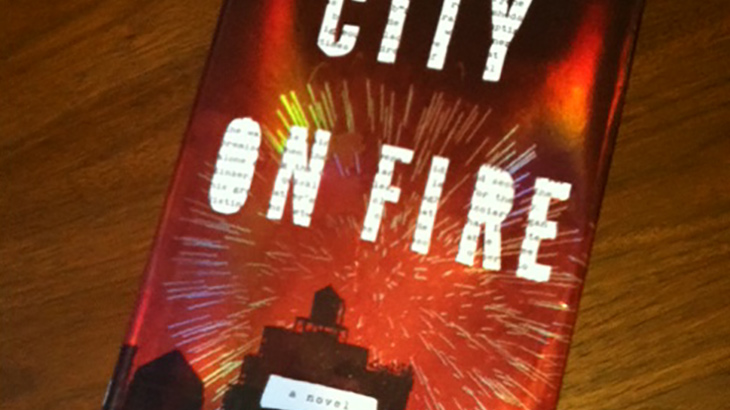One thing that I’m grateful for in 2016 is that I finally finished City on Fire. My girlfriend told me about this hotly anticipated book and the two million dollar advance for its first time author. So, I got us copies for her birthday so we could read it together.
We both started tearing through this nine hundred plus page tome marveling at the skill and interconnectedness of its characters. It was pretty great for the first four hundred pages.
But the last five hundred?
We choked down the rest of the book like boiled brussels sprouts (for me, she actually likes brussels). I’m glad to finally be done, to not have this brick in my bag on the subway anymore. Yeah, complaining about the weight of the book is rather petty but if you don’t like petty, I’d stop reading now.
The novel was at its best when it was delving into the worlds of each character. Mercer Goodman and his boyfriend William Hamilton-Sweeney and William’s sister Regan, Regan’s husband Keith Lamplighter, his mistress Samantha, and Sam’s friend Charlie Weisberger, plus the conniving usurper of the Hamilton-Sweeney throne, Amory Gould, whose sister married William Hamilton-Sweeney II, father of the aforementioned William Hamilton-Sweeney, grandfather of Regan’s son William (Will) Hamilton-Sweeney.
Have you got all that? Because there’s more!
The addition of a cop named Pulaski and a reporter named Groskoph covering a murder actually doesn’t weigh down the novel. It still worked and I was devouring it. But then the novel started to devour itself.
In the second half we started to have character backstories hammered home for us. Hard. The events in each character’s life were revisited and rehashed without revealing anything that we didn’t already know. And we started following characters whose narratives really did start weighing down the novel. Do we need to follow Jenny Nguyen, the assistant to Augenblink, artistic mentor of William Hamilton-Sweeney?
Author Garth Risk Hallberg thinks so.
Part of this novel’s appeal was its focus on the seventies in New York, a period that it is quite in vogue to long for. It’s not that the novel fails to get the seventies right, it’s that it doesn’t seem to try that hard. How is it, aside from the absence of cellphones or computers or any social media, that this couldn’t be present day? Aside from the wealthy family saga and the disaffected teenagers from Long Island, the only thing that places it firmly in the seventies is the presence of a punk band. But even that could fit in any decade since the seventies. I found myself thinking, Hallberg needs to read Please Kill Me and Ladies and Gentlemen, the Bronx Is Burning. Then I got to the end and, in the acknowledgements, found that he had.
This guy’s appetite for circumlocution is never sated and his capacious cranium is replete with polysyllabic splendor.
I enjoy the aesthetic of the whole downtown Patti Smith East Village squat Lou Reed black leather jacket Williams S. Burroughs heroin trash Ramones thing. I really do. But, ultimately, the actual art and music has never resonated with me. The fact of New York now is this: we all bought our Velvet Undground t-shirt at Urban Outfitters. Anyone who wasn’t there and waxes nostalgic about this era often sounds like someone giving a eulogy for a person he didn’t know. (You can hear Hallberg speak for himself here and here and probably many other places.)
Around page 700 (or was it 800?) a character has a conversation with Patti Smith in a dream. Now, up to this point, I had been marking interesting passages in the margin with a pen. I put an x next to interesting plot points and, at times, “70’s?” next to references I thought may not have been accurate. Mercer remembering the headline “Ford To City: Drop Dead” seemed a little on the nose and Jenny Nguyen joining a dating service during the dawn of singles bars seemed like a present day analogy that didn’t quite fit. But when the Patti Smith dream conversation happened, I actually wrote “fuck you” in the margin of the book. I’m not joking.

And I would never want to play Scrabble with Hallberg. While I was marking passages in the book, I was also keeping a list of vocab word that I didn’t get. This guy’s appetite for circumlocution is never sated and his capacious cranium is replete with polysyllabic splendor. I guess I should know what propinquity, deracinated and eschatological mean. I should know what postprandial, macrocephalic, and homuncular mean, I guess. But I don’t. If you’ve got nine hundred pages, you can stretch your legs a bit verbally but it still became annoying.
The climax of the book takes place during the black out of 1977. This was the most frustrating part of the novel. I suppose it was intended to be a frenzied combination and culmination of all of the relationships in the novel but it read like a confusing fever dream, occasionally arbitrarily jumping from the current timeline, another problem from which the book suffers throughout second half.
I take my pop culture far too seriously and I’m being a jerk about a very talented writer’s ambitious novel but I just had to get to the end to, in a metaphor that would actually suit a plot line of the novel, search through the rubble of this book. But I also wanted to know, is anyone else aware of this book? Why don’t I see anyone reading it on the subway? Is it too hard to carry? (If memory serves, the not-lightweight The Goldfinch was all over the place.) Is it on Kindles and I’m just not seeing it? How did this book happen and what went wrong?
In Adaptation, Bob McKee (the character) says, “You can have flaws, problems, but wow them in the end, and you’ve got a hit.” Bob McKee’s presence was somewhat satirical but that advice rings true. Hallberg wowed me in the beginning but only in the beginning and that, it seems, is City on Fire’s greatest flaw.




